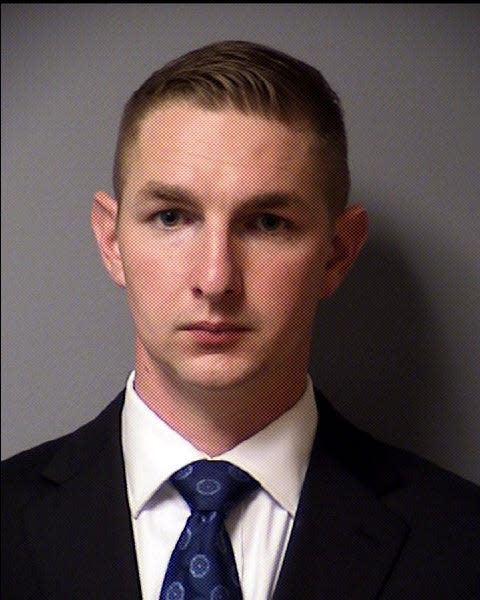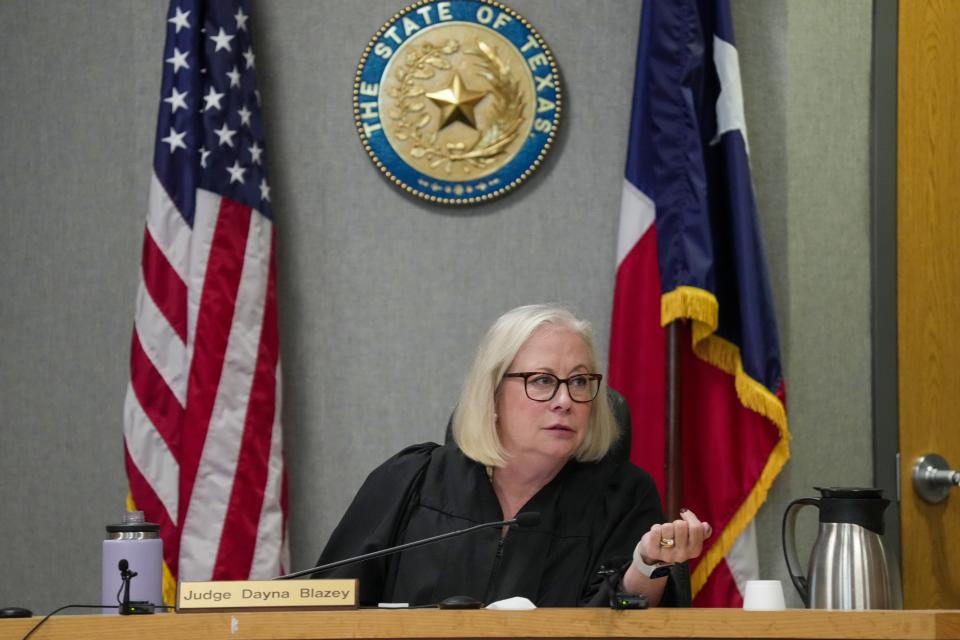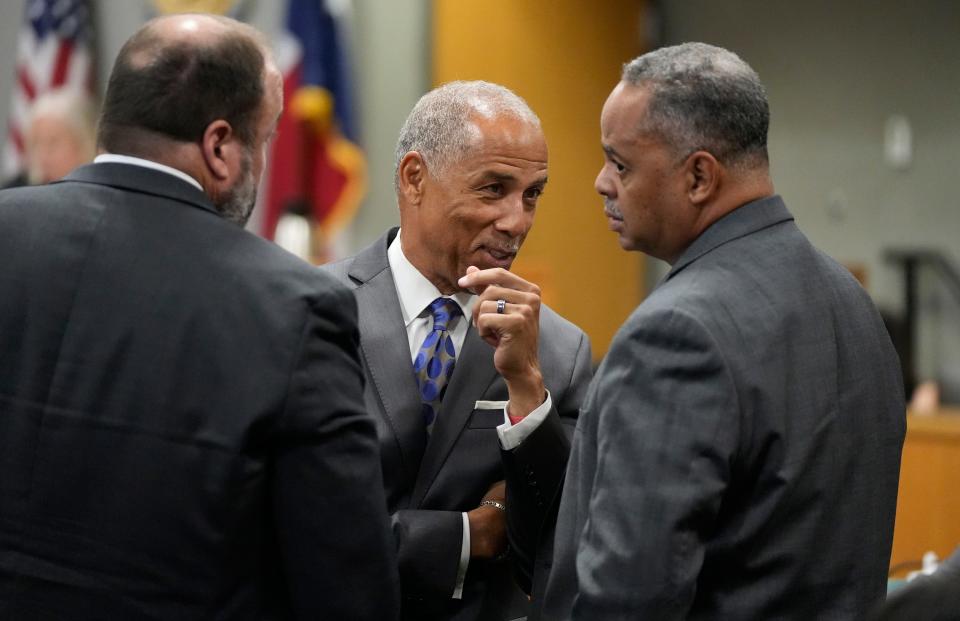In Christopher Taylor trial, prosecutors question 'different' treatment for police in criminal probes
During the fourth and fifth days of the murder trial against Austin police officer Christopher Taylor — charged in connection with the April 2020 shooting death of Michael Ramos — prosecutors lingered on the nature of the criminal investigation into Taylor’s actions.
The Austin Police Department’s Special Investigations Unit undertakes criminal investigations into officer-involved shootings.
The two latest days of the trial also offered more glimpses into the defense’s strategy. Taylor’s attorneys, Doug O’Connell and Ken Ervin, have largely been reserved during their cross-examination of state witnesses and had elected not to give an opening statement on the trial's first day.

Prosecutors hone in on conduct of Special Investigations Unit around Ofc. Taylor
Taylor’s uncle, Scott Askew, has been present in the courtroom all week, but it wasn’t until Thursday that his role in the Austin Police Department became part of the trial.
Prosecutors revealed that, at the time of the shooting, Askew was a senior officer in the Special Investigations Unit. Prosecutors argued that though Askew was formally “walled off” from the investigation into Taylor, he maintained a supervisory role over the unit at large.
Askew also arrived on the scene in the immediate aftermath of the shooting. Taylor requested that his uncle be present as his “support officer.”
More: What Austin police officers said in testimony during Christopher Taylor's murder trial
Officer Taber White testified that police can designate a peer support officer, who can accompany them after a “traumatic experience.”
The jury left the courtroom while prosecutors and defense attorneys argued over whether this information could be presented to jurors.
Generally, a judge will decide whether the “probative value” — how important a piece of evidence is to the determination of a fact — outweighs the danger of prejudicing the jury against a party.
Judge Dayna Blazey ultimately ruled that it would be overly prejudicial for jurors.
Blazey allowed prosecutors to tell the jury that Taylor’s uncle was present on the scene as his support officer, but not that Askew was in the Special Investigations Unit.

Different treatment for officer suspects?
On Friday morning, prosecutors continued probing into how the Special Investigations Unit looked into the circumstances of Ramos’ death. Prosecutors put Dan Mireles, the unit's detective in charge of Taylor's case, on the stand.
In his questioning of Mireles, Assistant District Attorney Rob Drummond suggested that suspects who are police officers receive different treatment than civilians.
Drummond pointed out that when Taylor and his uncle were placed into a patrol car after the shooting, the in-car camera was turned off.
Drummond also said that while a civilian suspect’s interview typically takes place as “soon as possible,” the Special Investigations Unit has a policy that at least “two sleep cycles” must pass before officer suspects can be interviewed. On the stand, Mireles corroborated the existence of this policy.

Mireles also confirmed that the unit’s typical procedure is to show officers their body camera footage before conducting an interview. Mireles said that letting officers view the footage is a “courtesy” meant to assist with their “recollection” of the event.
Drummond then asked if civilian suspects would be shown footage of a suspected crime before being interviewed by police. Mireles said they typically would not.
The investigation into Taylor was unusual even for an inquiry into an officer-involved shooting.
On the witness stand, Mireles said he never conducted a verbal interview of Taylor. Instead, only Taylor’s attorneys viewed footage from the shooting. They then provided Mireles with a written statement.
Mireles agreed with a prosecutor’s characterization that this was a “deviation” from the standard operating procedures of the Special Investigations Unit.
More: 'I feel like I shot him': 911 caller regrets inaccurate statement that Mike Ramos was armed
Medical examiner explained autopsy report
On Thursday, jurors heard from a paramedic who responded to the scene of the shooting, as well as the Austin police officer who accompanied the ambulance to the hospital.
Keith Pinckard, Travis County’s chief medical examiner, walked jurors through Ramos’ autopsy report. Prosecutors presented autopsy photos of the injuries Ramos suffered during the shooting.
Ramos had been shot three times — on his head, forearm and abdomen.
The autopsy report described the presence of illegal drugs in Ramos’ system. A medical examiner found traces of cocaine, methamphetamine, amphetamine and eutylone (commonly referred to as “bath salts”).
Pinckard told defense attorneys that the concentration of a particular drug in someone’s system is not “generally useful” to predicting its impact on someone’s behavior.
Ervin, one of Taylor’s attorneys, also indicated that the autopsy report contained references to Ramos’ mental health history.
Officer who shot Ramos with beanbag round says he wanted to “de-escalate”
Prosecutors continued their questioning of officers who were present when Taylor shot and killed Ramos. On Thursday, prosecutors called officers James Morgan and Mitchell Pieper to the witness stand.
Morgan was Pieper’s training officer. In April 2020, Pieper had only been on the force for three months.
That day, Pieper shot Ramos with what police call “less lethal” beanbag ammunition.
Drummond gave Pieper a copy of a statement he made in the aftermath of Ramos’ death. In the statement, Pieper described his thought process prior to shooting Ramos with the “less lethal” round.
In the statement, Pieper said he did not think there was an “immediate threat” and wanted to “de-escalate” the situation.
In his questioning, Drummond suggested that using the “less lethal” round actually escalated the situation.
In police body-worn camera footage, Ramos can be seen getting into his vehicle almost immediately after being struck by the “less lethal” round.
This article originally appeared on Austin American-Statesman: At Christopher Taylor trial, prosecutors question treatment of police

